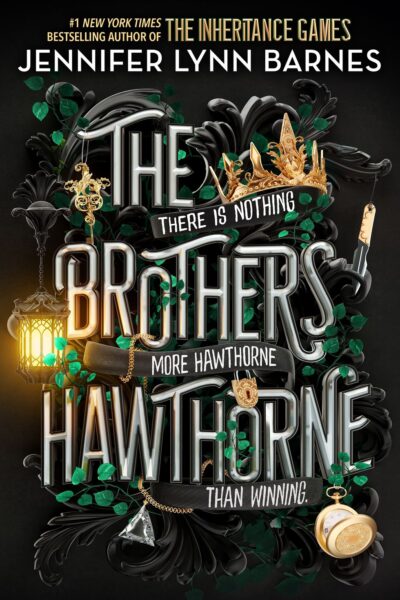
The Brothers Hawthorne
TWELVE AND A HALF YEARS AGO
by Barnes, Jennifer LynnThe chapter opens with Grayson and Jameson Hawthorne, two brothers who thrive on bending rules, preparing to outsmart their family’s Christmas morning tradition. The rule states no one may leave their rooms before seven, but the brothers cleverly set the clocks forward to 6:25, ensuring an early start. Their competitive spirit ignites as they race through Hawthorne House, only to discover their five-year-old brother, Xander, has already arrived by creatively rolling instead of stepping. The scene captures the Hawthorne siblings’ playful rivalry and ingenuity, setting the tone for their dynamic.
Upon reaching the Great Room, the brothers are stunned to find it stripped of all Christmas decorations and presents. The absence of holiday cheer suggests their grandfather has retaliated against their rule-breaking. However, Jameson’s sharp eye spots a lone ornament hidden in the tree, containing the first clue in a puzzle. This discovery shifts the narrative from disappointment to intrigue, as the brothers realize their grandfather has replaced traditional gifts with an elaborate game—a hallmark of the Hawthorne family’s unconventional traditions.
The siblings split up to search the estate’s six Christmas trees, each yielding an ornament with a puzzle piece. Assembling the pieces reveals a blank square, but with the final clue—a keychain flashlight—they uncover hidden instructions pointing to the southwest corner of the estate. The brothers’ excitement grows as they decode each step, showcasing their teamwork and problem-solving skills. Nash, the eldest, takes charge, driving them toward the next phase of the game in a golf cart, hinting at a grander surprise awaiting them.
The chapter concludes with the brothers arriving at the southwest corner, their anticipation palpable as they glimpse an undisclosed but awe-inspiring sight. The narrative underscores the Hawthorne family’s love for challenges and games, blending mischief with deeper themes of familial bonds and tradition. The cliffhanger ending leaves readers eager to discover the nature of the final “present,” reinforcing the book’s tone of mystery and adventure.
FAQs
1. How did the Hawthorne brothers circumvent the Christmas morning rule about not leaving their rooms before seven o’clock?
Answer:
The brothers exploited a loophole in the rule by setting all five grandfather clocks in Hawthorne House forward to strike seven at 6:25 AM. Jameson and Grayson coordinated this plan using military-grade walkie-talkies, demonstrating their early understanding of rules as challenges to be gamed rather than strict prohibitions. Their success in manipulating time shows their strategic thinking, though they remained cautious enough to consider a Plan B if their grandfather had counter-manipulated the clocks.2. What does Xander’s method of arriving first reveal about the Hawthorne family’s approach to rules and competition?
Answer:
Xander’s creative solution—log-rolling from his bedroom to avoid technically “stepping a foot” outside his room—highlights the Hawthorne family’s culture of interpreting rules literally while encouraging unconventional problem-solving. His approach impressed his older brothers, showing that cleverness is valued over brute force in their competitive dynamics. This moment also establishes Xander as an unexpectedly formidable competitor despite being the youngest, reinforcing the theme that all Hawthornes, regardless of age, engage in the family’s trademark strategic games.3. Analyze how the discovery of the missing Christmas decorations serves as both a narrative twist and a character development moment.
Answer:
The barren Great Room initially appears as punishment for rule-breaking, testing the brothers’ resilience when their plans seem to fail. This twist transitions the chapter from physical competition to intellectual challenge, revealing key traits: Grayson’s analytical stillness, Jameson’s determined observation skills, and Nash’s protective instincts toward Xander. The stripped-down tree becomes a metaphor for hidden complexity—the single ornament represents their grandfather’s teaching that rewards require perseverance. This moment matures their understanding of games, shifting from simple rule-bending to appreciating layered puzzles.4. What does the puzzle-solving sequence reveal about the brothers’ collaborative and individual strengths?
Answer:
The scavenger hunt showcases their dynamic: Grayson’s precision in opening the ornament contrasts with Jameson’s impulsive discovery of the first clue, while Nash provides guidance and Xander offers enthusiastic participation. Their collective effort to find all six trees demonstrates teamwork, yet tensions surface when both Grayson and Jameson reach for the final ornament—highlighting their competitive streaks. The flashlight revelation combines Jameson’s quick thinking with Grayson’s logical deduction about the key’s purpose, proving their skills complement each other in problem-solving.5. How does the chapter establish the theme of games as a foundational element of the Hawthorne family identity?
Answer:
From manipulating clocks to interpreting puzzle clues, every action frames life at Hawthorne House as a series of strategic challenges. The brothers instinctively approach Christmas as a competition (“I win!”), while their grandfather designs elaborate puzzles that teach problem-solving. The narrative emphasizes there are “no coincidences” in their world—every detail exists to be analyzed. This establishes games as both recreation and training, shaping the brothers’ worldview. The empty Great Room twist reinforces that losing is part of gameplay, preparing them for higher-stakes challenges later in life.
Quotes
1. “Grayson and Jameson Hawthorne knew the rules. You couldn’t get around rules if you didn’t know them.”
This opening line establishes the Hawthorne brothers’ mischievous yet strategic approach to life, framing the entire chapter’s theme of finding loopholes and playing games within constraints.
2. “Hawthornes always had a Plan B. But this time, it proved unnecessary.”
This quote encapsulates the family’s preparedness mindset while also showing their adaptability when plans change—a key dynamic in their problem-solving approach.
3. “There were no coincidences in Hawthorne House.”
A pivotal realization that shifts the brothers from disappointment to active problem-solving, representing the chapter’s core message about looking deeper for hidden meanings.
4. “That was the thing about games: Sometimes you lost.”
This moment of vulnerability contrasts with their usual confidence, showing an important emotional beat where the brothers confront potential failure before rallying.
5. “Christmas at Hawthorne House was magic.”
This simple declaration captures the wonder and tradition that drives the brothers’ determination throughout the chapter, even when faced with disappointment.
